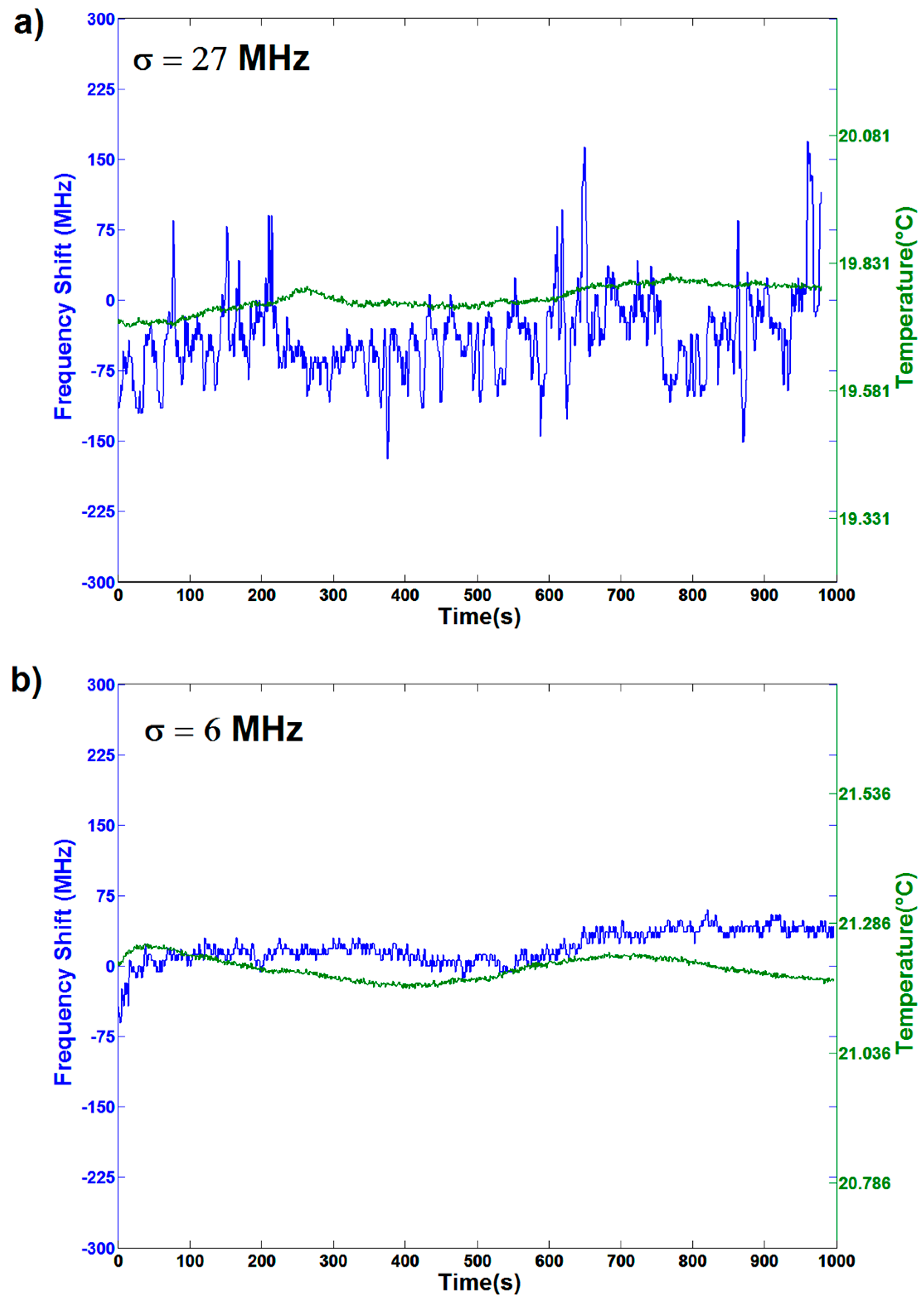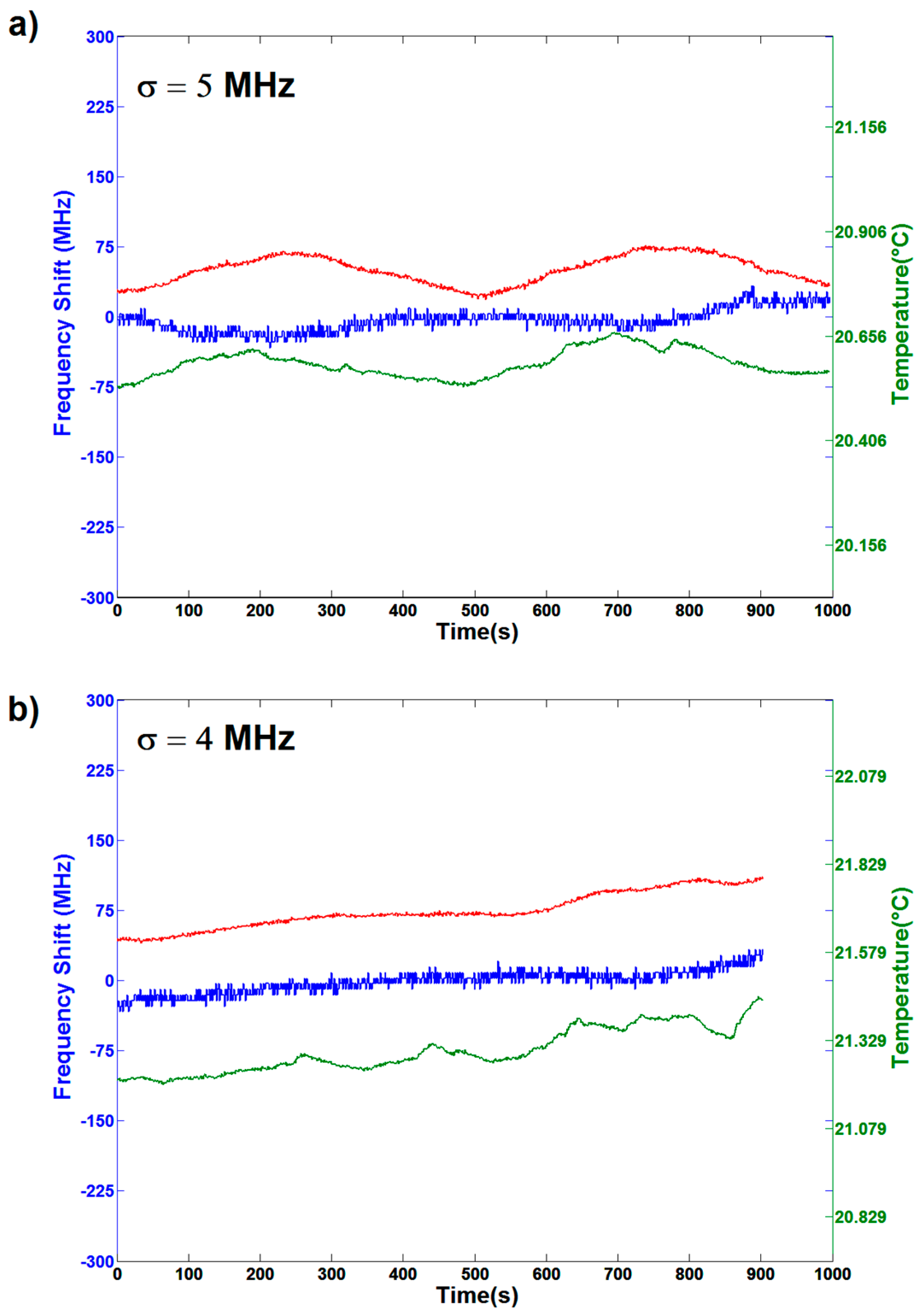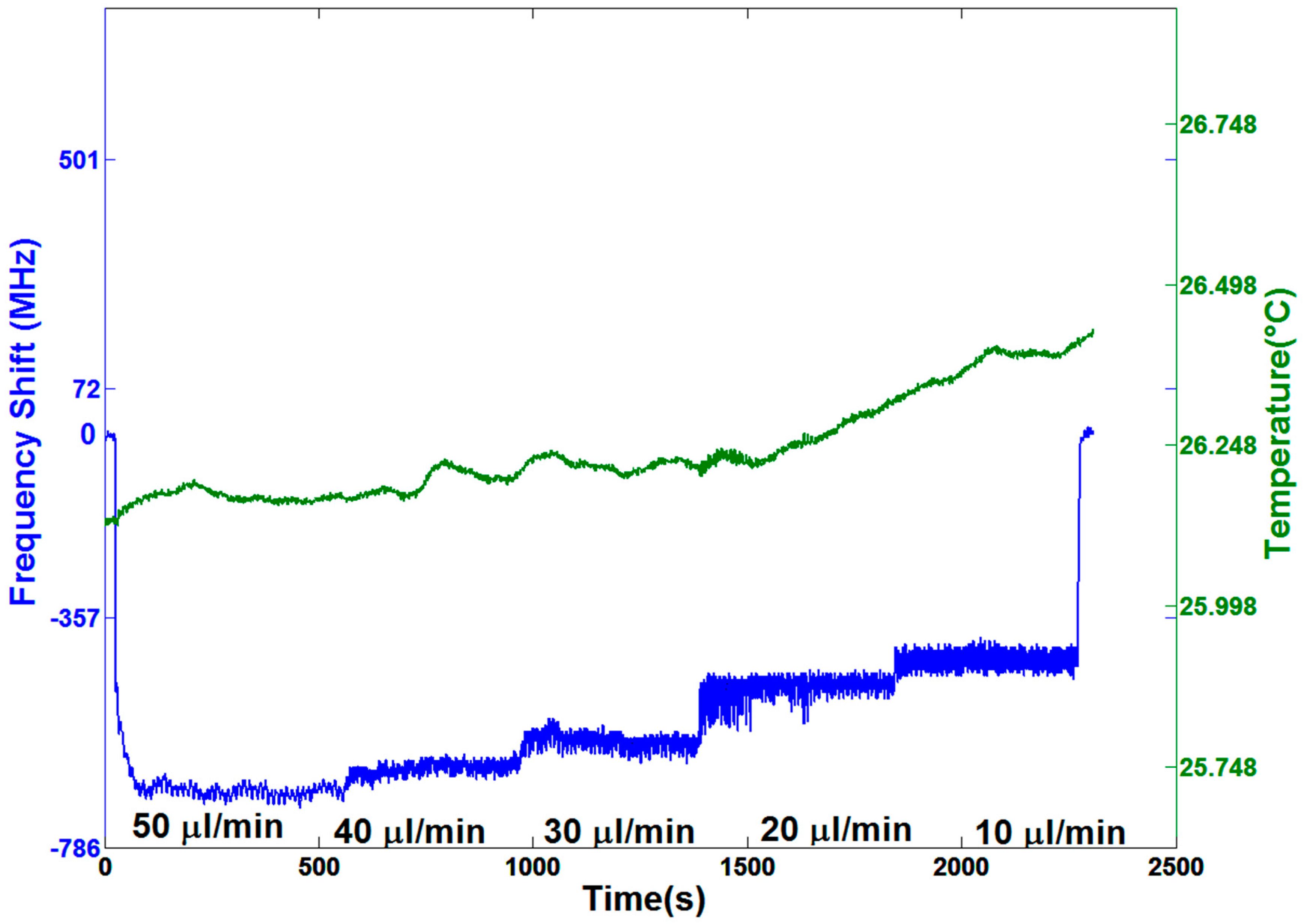Resonance Frequency of Optical Microbubble Resonators: Direct Measurements and Mitigation of Fluctuations
Abstract
:1. Introduction
2. Materials and Methods
2.1. Silica Glass OMBR
2.2. Coupling and Enclosing System
2.3. Lasers and Detectors
2.4. Acquisition System
2.5. Pumping Systems
2.6. Data Analysis
3. Results and Discussion
3.1. Static Resonance Stability of the OMBR System Coupled in Air
3.2. Static Resonance Stability When OMBR System is Encased
3.3. Dynamic Resonance Stability When Using a Peristaltic Pump
3.4. Dynamic Resonance Stability When Using a Syringe Pump
4. Conclusions
Supplementary Materials
Acknowledgments
Author Contributions
Conflicts of Interest
References
- Sumetsky, M.; Windeler, R.S.; Dulashko, Y. Optical microbubble resonator. Opt. Lett. 2010, 35, 898–900. [Google Scholar] [CrossRef] [PubMed]
- Berneschi, S.; Farnesi, D.; Cosi, F.; Conti, G.N.; Pelli, S.; Righini, G.C.; Soria, S. High Q silica microbubble resonators fabricated by arc discharge. Opt. Lett. 2011, 36, 3521–3523. [Google Scholar] [CrossRef] [PubMed]
- Zhang, X.; Liu, L.; Xu, L. Ultralow sensing limit in optofluidic micro-bottle resonator biosensor by self-referenced differential-mode detection scheme. Appl. Phys. Lett. 2014, 104, 033703. [Google Scholar] [CrossRef]
- Li, H.; Fan, X. Characterization of sensing capability of optofluidic ring resonator biosensors. Appl. Phys. Lett. 2010, 97, 011105. [Google Scholar] [CrossRef]
- Stoian, R.I.; Bui, K.V.; Rosenberger, A.T. Silica hollow bottle resonators for use as whispering gallery mode based chemical sensors. J. Opt. 2015, 17, 125011. [Google Scholar] [CrossRef]
- Ward, J.M.; Yang, Y.; Chormaic, S.N. Highly Sensitive Temperature Measurements with Liquid-Core Microbubble Resonators. IEEE Photon. Technol. Lett. 2013, 25, 2350–2353. [Google Scholar] [CrossRef]
- Henze, R.; Seifert, T.; Ward, J.; Benson, O. Tuning whispering gallery modes using internal aerostatic pressure. Opt. Lett. 2011, 36, 4536–4538. [Google Scholar] [CrossRef] [PubMed]
- Madugani, R.; Yang, Y.; Le, V.H.; Ward, J.M.; Chormaic, S.N. Linear Laser Tuning Using a Pressure-Sensitive Microbubble Resonator. IEEE Photon. Technol. Lett. 2016, 28, 1134–1137. [Google Scholar] [CrossRef]
- Li, M.; Wu, X.; Liu, L.; Xu, L. Kerr parametric oscillations and frequency comb generation from dispersion compensated silica micro-bubble resonators. Opt. Express 2013, 21, 16909–16913. [Google Scholar] [CrossRef] [PubMed]
- Farnesi, D.; Barucci, A.; Righini, G.C.; Berneschi, S.; Soria, S.; Nunzi, G. Optical Frequency Conversion in Silica-Whispering-Gallery-Mode Microspherical Resonators. Phys. Rev. Lett. 2014, 112, 093901. [Google Scholar] [CrossRef] [PubMed]
- Shen, B.Q.; Yu, X.-C.; Zhi, Y.; Wang, L.; Kim, D.; Gong, Q.; Xiao, Y.-F. Detection of Single Nanoparticles Using the Dissipative Interaction in a High-Q Microcavity. Phys. Rev. Appl. 2016, 5, 024011. [Google Scholar] [CrossRef]
- Shao, B.; Jiang, X.-F.; Yu, X.-C.; Li, B.-B.; Clements, W.R.; Vollmer, F.; Wang, W.; Xiao, Y.-F.; Gong, Q. Detection of Single Nanoparticles and Lentiviruses Using Microcavity Resonance Broadening. Adv. Mater. 2013, 5, 5616–5620. [Google Scholar] [CrossRef] [PubMed]
- Dong, Y.; Wang, K.; Jin, X. Packaged microsphere-taper coupling system with a high Q factor. Appl. Opt. 2015, 54, 277–284. [Google Scholar] [CrossRef] [PubMed]
- Dong, Y.; Jin, X.; Wang, K. Packaged and robust microcavity device based on a microcylinder-taper coupling system. Appl. Opt. 2015, 54, 4016–4022. [Google Scholar] [CrossRef]
- Wang, P.; Ding, M.; Murugan, G.S.; Bo, L.; Guan, C.; Semenova, Y.; Wu, Q.; Farrell, G.; Brambilla, G. Packaged, high-Q, microsphere-resonator based add-drop filter. Opt. Lett. 2015, 39, 5208–5211. [Google Scholar] [CrossRef] [PubMed]
- Yan, Y.-Z.; Zou, C.-L.; Yan, S.-B.; Sun, F.-W.; Ji, Z.; Liu, J.; Zhang, Y.-G.; Wang, L.; Xue, C.-Y.; Zhang, W.-D.; et al. Packaged silica microsphere-taper coupling system for robust thermal sensing application. Opt. Express 2011, 19, 5753–5759. [Google Scholar] [CrossRef] [PubMed]
- Tang, T.; Wu, X.; Liu, L.; Xu, L. Packaged optofluidic microbubble resonators for optical sensing. Appl. Opt. 2016, 55, 395–399. [Google Scholar] [CrossRef] [PubMed]
- Cosci, A.; Quercioli, F.; Farnesi, D.; Berneschi, S.; Giannetti, A.; Cosi, F.; Barucci, A.; Conti, G.N.; Righini, G.; Pelli, S. Confocal reflectance microscopy for determination of microbubble resonator thickness. Opt. Express 2015, 23, 16693–16701. [Google Scholar] [CrossRef] [PubMed]
- Kamikawachi, R.C.; Abe, I.; Paterno, A.S.; Kalinowski, H.J.; Muller, M.; Pinto, J.L.; Fabris, J.L. Determination of thermo-optic coefficient in liquids with fiber Bragg grating refractometer. Opt. Commun. 2008, 281, 621–625. [Google Scholar] [CrossRef]
- Ward, J.M.; Dhasmana, N.; Chormaic, S.N. Hollow core, whispering gallery resonator sensors. Eur. Phys. J. Spec. Top. 2014, 223, 1917–1935. [Google Scholar] [CrossRef]
- Brenci, M.; Calzolai, R.; Cosi, F.; Nunzi, G.; Righini, G.C.; Pelli, S. Microspherical resonators for biophotonic sensors. In Proceedings of the Lightmetry and Light and Optics in Biomedicine 2004, Warsaw, Poland, 20–22 October 2004.
- Yang, Y.; Ward, J.; Chormaic, S.N. Quasi-droplet microbubbles for high resolution sensing applications. Opt. Express 2014, 22, 6881–6898. [Google Scholar] [CrossRef] [PubMed]
- He, L.; Xiao, Y.-F.; Zhu, J.; Ozdemir, S.K.; Yang, L. Oscillatory thermal dynamics in high-Q PDMS coated silica toroidal microresonators. Opt. Express 2009, 17, 9571–9581. [Google Scholar] [CrossRef] [PubMed]
- Ma, Q.; Rossmann, T.; Guo, Z. Micro-temperature sensor based on optical whispering gallery mode of fiber taper-microsphere coupling system. In Proceedings of the Photonic Fiber and Crystal Devices: Advances in Materials and Innovations in Device Applications III, San Diego, CA, USA, 2–5 August 2009.
- White, I.M.; Oveys, H.; Fan, X. Liquid-core optical ring-resonator sensors. Opt. Lett. 2006, 31, 1319–1321. [Google Scholar] [CrossRef] [PubMed]
- Judy, J.; Maynes, D.; Webb, B.W. Characterization of frictional pressure drop for liquid flows through microchannels. Int. J. Heat Mass Transf. 2002, 45, 3477–3489. [Google Scholar] [CrossRef]
- Vollmer, F.; Arnold, S. Whispering-gallery-mode biosensing: Label-free detection down to single molecules. Nat. Methods 2008, 5, 591–596. [Google Scholar] [CrossRef] [PubMed]





© 2016 by the authors; licensee MDPI, Basel, Switzerland. This article is an open access article distributed under the terms and conditions of the Creative Commons Attribution (CC-BY) license (http://creativecommons.org/licenses/by/4.0/).
Share and Cite
Cosci, A.; Berneschi, S.; Giannetti, A.; Farnesi, D.; Cosi, F.; Baldini, F.; Nunzi Conti, G.; Soria, S.; Barucci, A.; Righini, G.; et al. Resonance Frequency of Optical Microbubble Resonators: Direct Measurements and Mitigation of Fluctuations. Sensors 2016, 16, 1405. https://doi.org/10.3390/s16091405
Cosci A, Berneschi S, Giannetti A, Farnesi D, Cosi F, Baldini F, Nunzi Conti G, Soria S, Barucci A, Righini G, et al. Resonance Frequency of Optical Microbubble Resonators: Direct Measurements and Mitigation of Fluctuations. Sensors. 2016; 16(9):1405. https://doi.org/10.3390/s16091405
Chicago/Turabian StyleCosci, Alessandro, Simone Berneschi, Ambra Giannetti, Daniele Farnesi, Franco Cosi, Francesco Baldini, Gualtiero Nunzi Conti, Silvia Soria, Andrea Barucci, Giancarlo Righini, and et al. 2016. "Resonance Frequency of Optical Microbubble Resonators: Direct Measurements and Mitigation of Fluctuations" Sensors 16, no. 9: 1405. https://doi.org/10.3390/s16091405









